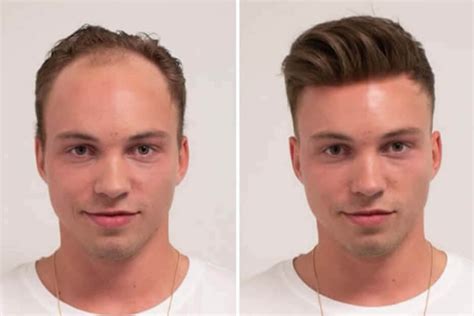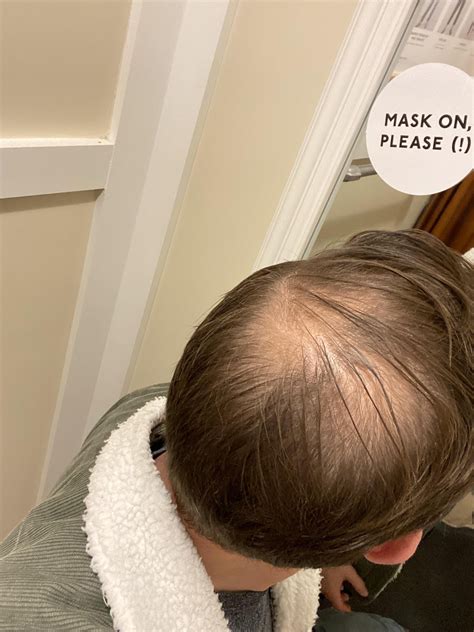Hair Loss on Top of Head: A Growing Concern
Hair loss, also known as alopecia, affects millions of people worldwide, with varying degrees of severity. Androgenic alopecia, or male-pattern baldness, is the most common type, affecting up to 50% of men by age 50. Female-pattern baldness, also known as androgenetic alopecia, is less common but still affects a significant number of women.

Types of Hair Loss on Top of Head
There are several types of hair loss that can affect the top of the head, including:
- Androgenic alopecia (AGA): Also known as male-pattern baldness or female-pattern baldness, AGA is the most common type of hair loss, caused by genetics and hormonal changes.
- Alopecia areata: This is an autoimmune condition that causes patchy hair loss on the scalp, but it can also affect other parts of the body.
- Telogen effluvium: This is a temporary form of hair loss that can be caused by various factors, such as stress, illness, or hormonal changes.
- Anagen effluvium: This is a less common type of hair loss that occurs when the hair follicles are damaged, such as by chemotherapy or radiation.
Causes of Hair Loss on Top of Head
Hair loss on top of head can be caused by various factors, including:
- Genetics: Androgenic alopecia is primarily caused by genetics, with certain genes increasing the risk of developing hair loss.
- Hormonal changes: Fluctuating hormone levels, such as during pregnancy, menopause, or thyroid problems, can contribute to hair loss.
- Stress: Chronic stress has been linked to hair loss, as it can trigger the release of hormones that can damage hair follicles.
- Nutritional deficiencies: Deficiencies in certain vitamins and minerals, such as iron, zinc, and biotin, can lead to hair loss.
- Medications: Some medications, such as chemotherapy drugs and blood thinners, can cause hair loss as a side effect.
- Medical conditions: Certain medical conditions, such as alopecia areata, lupus, and thyroid disorders, can result in hair loss.
Treatments for Hair Loss on Top of Head
There are several treatments available for hair loss on top of head, including:
- Medications: Minoxidil and finasteride are two FDA-approved medications that can help slow down or stop hair loss in some individuals.
- Hair transplant: This surgical procedure involves harvesting hair follicles from another part of the body and transplanting them to the balding area.
- Laser therapy: This treatment uses low-level laser light to stimulate hair growth.
- Platelet-rich plasma (PRP): This involves injecting concentrated platelets from the patient’s own blood into the balding area to promote hair growth.
Prevention and Management of Hair Loss on Top of Head
While not all causes of hair loss are preventable, there are some steps you can take to manage and prevent hair loss on top of head, including:
- Maintain a healthy lifestyle: Manage stress, eat a healthy diet, and get enough sleep.
- Use gentle hair care products: Avoid harsh chemicals and heat styling, and use volumizing shampoos and conditioners.
- Protect your hair from the sun: Wear a hat or use a UV-protective hair spray when exposed to the sun.
- Consider scalp treatments: Use hair growth serums or scalp massages to promote healthy hair follicles.
Common Mistakes to Avoid
When dealing with hair loss on top of head, it’s important to avoid certain common mistakes, such as:
- Ignoring the problem: Hair loss can be a sign of an underlying medical condition, so it’s important to seek medical advice if you experience sudden or excessive hair loss.
- Using ineffective treatments: Not all hair loss treatments are effective, and some may even worsen hair loss.
- Overusing hair products: Using too many hair products or styling tools can damage the hair and contribute to hair loss.
- Becoming discouraged: Hair loss can be a frustrating experience, but it’s important to stay positive and explore different treatment options.
Conclusion
Hair loss on top of head can be a challenging condition, but it’s важно to remember that there are various options available for treatment and management. By understanding the causes and types of hair loss, and adopting effective prevention and management strategies, you increase your chances of reducing or reversing hair loss and achieving healthy hair growth.
| Type of Hair Loss | Causes | Symptoms | Treatment Options |
|---|---|---|---|
| Androgenic Alopecia | Genetics, hormonal changes | Gradual thinning and receding hairline | Minoxidil, finasteride, hair transplant |
| Alopecia Areata | Autoimmune condition | Sudden patchy hair loss | Corticosteroids, immunotherapy |
| Telogen Effluvium | Stress, illness, hormonal changes | Excessive shedding of hair | Lifestyle changes, stress management |
| Anagen Effluvium | Chemotherapy, radiation | Sudden hair loss within days or weeks | Supportive care, post-treatment hair growth |
| Nutrient | Recommended Daily Intake | Benefits for Hair Growth |
|---|---|---|
| Iron | 8-27 mg | Prevents anemia, which can lead to hair loss |
| Zinc | 8-11 mg | Supports hair follicle growth and prevents shedding |
| Biotin | 30-100 mcg | Strengthens hair and prevents breakage |
| Home Remedies for Hair Loss on Top of Head |
|—|—|
| Onion juice | Apply onion juice to the scalp and leave it on for 30 minutes before washing it out. |
| Green tea | Drink green tea or apply it topically to the scalp as it contains antioxidants that can promote hair growth. |
| Rosemary oil | Massage rosemary oil into the scalp to stimulate circulation and hair growth. |
| Coconut oil | Apply coconut oil to the hair and scalp as it nourishes and moisturizes the hair, reducing breakage. |
| Hair Loss Prevention Tips |
|—|—|
| Manage stress | Stress can trigger hair loss, so it’s important to find effective stress management techniques. |
| Eat a healthy diet | A balanced diet that includes plenty of fruits, vegetables, and whole grains can provide the nutrients necessary for healthy hair growth. |
| Get enough sleep | Sleep deprivation can disrupt hormone levels and contribute to hair loss. |
| Avoid harsh hair care products | Using harsh chemicals and heat styling tools can damage the hair, leading to breakage and hair loss. |
| Protect your hair from the sun | UV rays can damage the hair, so wear a hat or use a UV-protective hair spray when exposed to the sun. |
